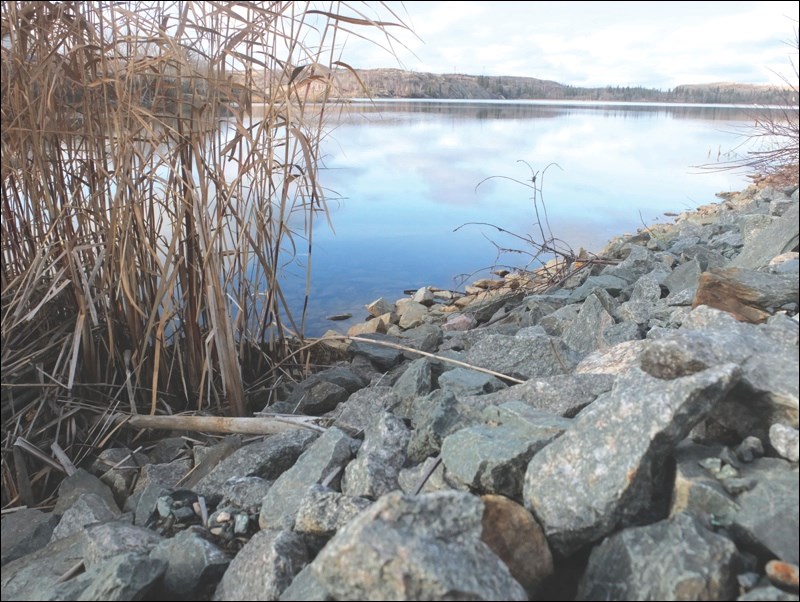Certain metal and element levels in Ross Lake breach government guidelines designed to protect fish and other aquatic life, but the impact of this toxicity is unclear, government tests show.
Manitoba Conservation and Water Stewardship (MCWS) most recently tested water samples from Ross Lake in July 2012 and July 2014. While most guidelines were met, some were not.
Results showed concentrations of five metals – cadmium, copper, zinc, aluminium and iron – exceeded guidelines for the protection of aquatic life. The same was true of selenium, a non-metal element. Tests also showed the pH level was too low.
“Based on the samples collected, we would expect there to be impacts to aquatic life,” a MCWS spokesman told The Reminder.
Asked to elaborate on those “impacts,” the spokesman said the exceedances of cadmium, copper and zinc relate to exposure for aquatic life in the long term, not the short term.
This “could cause non-lethal impacts over the long term, such as decreased growth, reduced reproduction or behavioral changes such as impacted swimming performance in fish, invertebrates and/or aquatic plants.”
Since guidelines for short-term exposure to cadmium, copper and zinc were met, the spokesman said “we would not expect concentrations to be high enough to cause immediate lethal impacts.”
The spokesman said the guidelines used for aluminium, iron and selenium are based on national objectives developed by the Canadian Council of Ministers of the Environment (CCME).
The CCME objectives are “generic guidelines designed to protect all forms of aquatic life and all aspects of the aquatic life cycles, including the most sensitive life stage of the most sensitive species over the long term and all across Canada,” the spokesman said.
“In Manitoba, exceedan-ces of these [CCME] parameters often occur naturally and aquatic life present in our lakes, rivers and streams are often adapted to or even prefer these higher concentrations. Also, given the history of impacts to Ross Lake from mining and domestic storm water, the local aquatic community has likely adapted to the conditions.”
Speaking on the test data as a whole, the spokesman said the results were “not surprising given the history of mining and smelting in the area. Mining has impacted the sediments of Ross Lake. Ross Lake sediments continue to be a source of metals to the water of Ross Lake.”
Ross Lake has also been historically impacted by domestic storm water as well as treated and untreated municipal effluent from the surrounding community, the MCWS spokesman added.
But not all factors influencing water quality in Ross Lake stem from human activity. The spokesman noted that two of the elevated metals, aluminium and iron, are abundant in the earth’s crust, with concentrations naturally high in many Manitoba lakes.
With authorization from government, Hudbay’s Flin Flon operations discharge treated wastewater into a “receiving environment” that includes Ross Lake, the spokesman said.
The Reminder gave Hudbay a chance to comment on the test results and the spokesman’s comments.
In an email, Rob Winton, head of Hudbay’s Manitoba operations, said the company is in compliance with all effluent discharge requirements spelled out by its provincial government licences.
He said Hudbay is also in compliance with the federal MMER (Metal Mining Effluent Regulations) for metals, suspended solids, ammonia and acute toxicity (Rainbow Trout).
“Thiobacilli are active during summer months, and are responsible for pH levels in Ross Lake,” Winton wrote, referring to a type of bacteria, “and can release hydrogen sulfide (rotten egg) odour as they consume sulfur compounds in Flin Flon Creek and Ross Lake.”
Flin Flon Creek drains into Ross Lake.
Exceedances of metals and elements in Ross Lake do not relate to human consumption, as the lake itself is not a source of drinking water. The province also does not recommend recreational swimming in the lake.
However, Ross Lake drains into Schist Lake, a water body from which some area cottagers are said to draw drinking water. So are the elevated metal levels a concern further down the chain?
“Private water system owners are responsible for ensuring the safety [of] their own water supplies, whether they draw water from a well or a surface water source, such as a lake or river,” the MCWS spokesman said. “The province does not regulate private residential water systems, though we do provide advice and guidance through our private well inquiry line.
“The province does not recommend drinking untreated surface water under any circumstances. If properly treated, surface may be used for other domestic purposes, such a bathing or laundry, but it would not be recommended for direct consumption. Cottagers are advised to obtain their drinking water from an approved regulated water source.”
Provincial testing further showed that Ross Lake’s pH – a measure of the concentration of hydrogen ions in water – was below the accepted guideline for the protection of aquatic life.
The lower pH could stem from the presence of acidifying bacteria, which can reduce pH in water, the spokesman said.
Some of the exceedances in Ross Lake were recorded in both 2012 and 2014, while others, including copper, aluminium and pH, were present in only one of those years.
(Editor’s note: The MCWS spokesman’s name was not published as per government policy that prohibits individuals providing background information from being cited by name.)




